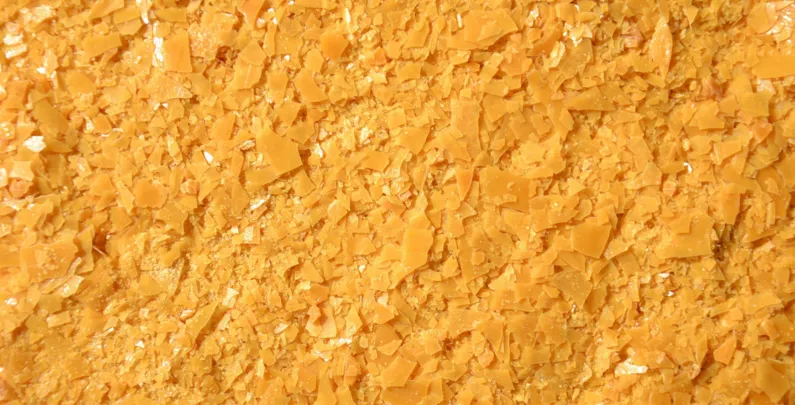In the previous blog post, we looked into beeswax, and now we will go into plant waxes.
Palm Wax
Palm wax is a type of plant-based stearin wax made from palm and palm kernel oil. The harvested palm fruit is mechanically pressed and refined in palm mills. The oil is extracted and steam distilled. Then, it is either hydrogenated, or chilled and then spun to isolate the waxes/oils with the highest melting point.
The process of separating the fat from the liquid is called fractionation. The oil is separated into both liquid (olein) and vegetable fat (palm wax). It then goes through further purification to achieve the correct texture.
Because palm oil is steamed distilled, it does not require harsh solvents and other harmful chemicals such as hexane, which is used in soybean refining. The exact refining process and chemicals used depends on the manufacturer.
The resulting wax is relatively smooth and hard, and bright-burning. It can also produce a distinct crystalline or feathering pattern or effect on the finished candle.
This type of wax has gained interest due to the increased “safety” of the refining process and the fact it is considered a renewable resource, but has led to controversy due to the effects of palm oil harvesting on the environment and and wildlife. Palm oil harvest contributes to mass deforestation and destruction of the environment and animal habitats, mainly in Malaysia and Indonesia. It is difficult to find a source of palm oil products that is truly sustainable.
Thermally oxidized (refined) palm oil (the oil is repeatedly subjected to high heat) is high in saturated fats, low in polyunsaturated fats, and can have adverse health effects on the body when consumed. Due to the effect of palm oil production on the environment and the health risks associated with consuming refined palm oil, some consumers may prefer to choose another type of wax rather than promote the palm oil industry.
If you choose to use palm wax, look for food grade palm oil that comes from plantations that are certified for using only sustainable, organic agricultural practices.
Carnauba
Carnauba wax, also known as Brazil wax, is a type of palm wax made from the leaves of the Brazilian palm tree, Copernica Cerifera. The plant naturally secretes the wax to maintain hydration and protect the leaves from damage. Only the Carnauba palms grown in the northeastern region of Brazil have this wax.
The leaves are collected and dried, and then beaten or scraped to loosen the powdery wax. The resulting wax flakes are melted, filtered, bleached, and moulded into blocks and cooled. There are several grades of carnauba wax depending on its “purity level,” or the level of refining and bleaching. A version of the wax is also available where water is used as the extraction agent.
In its pure state, it is a solid that has a yellow to yellow-brown colour. The colour and quality may vary depending on the age of the leaves and the handling in the production process. The wax is not readily soluble and usually needs additional ingredients such as solvents or oils to make it into a liquid form for use in making products.
It is extremely hard (one of the hardest naturally occurring waxes), durable, has a higher melting point than other waxes, and can produce a glossy finish. It is used in numerous applications such as in candles, candies, polishes, varnishes, printing inks, and cosmetic, dental and pharmaceutical products to provide a polish or coating or act as a hardening or gelling agent. It may also be combined with other waxes to improve their strength. In many applications it has been replaced by cheaper synthetics, but it is still frequently used.
Carnauba wax is considered biodegradable and sustainable since, if harvested properly, the leaves regrow. However, if purchasing carnauba wax, it is still important to obtain it from a source that is committed to sustainable, organic practices and the conservation of the carnauba palm. The palm tree needs time to reach full productivity, and the leaves need time to grow back. The wax may also be more expensive.
Bayberry Wax
Bayberry wax, also sometimes referred to as myrtle wax, is a green (or olive-coloured) vegetable wax derived from the fruit of the American bayberry bush or English bog myrtle. The process of obtaining the wax has not changed much since its discovery by America’s Colonial women. The berries are boiled, causing their waxy coating to be released. The wax is then skimmed from the surface of the water and left to harden.
This process can be tedious and it can take anywhere from 4 to 15 pounds of berries to produce one pound of wax. Bayberry wax also has its own distinct, earthy aroma that is woodsy, warm and spicy. The aroma makes it a popular wax for use in taper and pillar candles and for use at Christmastime. It can also be mixed with other waxes to provide a natural scent to other waxes, or to strengthen the bayberry wax. The unique scent does not appeal to everyone, however, and cannot be overridden, hidden, or successfully blended with other fragrances.
It is considered a good vegan substitute to beeswax, though it is more expensive and more brittle. Candles made from pure bayberry wax may break easier.
In the next blog post, we will look into soy wax.


Leave a Reply
You must be logged in to post a comment.